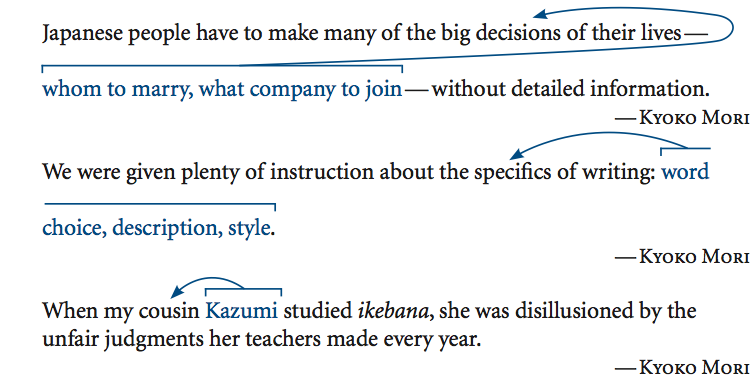Grammar as Rhetoric and Style
Appositives
An appositive is a noun or noun phrase that tells you more about a nearby noun or pronoun. In each sentence below, the appositive is bracketed. The arrow shows the noun or pronoun that the appositive describes.


Punctuation and Appositives
The last example given does not use punctuation to set off the appositive from the rest of the sentence, but the others do. Here’s why: If the appositive is not essential to the meaning of the sentence but is more of an aside or parenthetical remark, then the writer uses punctuation to set off the appositive. If the appositive is essential to the meaning of the sentence, then the writer does not set off the appositive with punctuation marks. Include what is essential; exclude what is not. In the second example given, the description of the principal is a minor detail, so Margaret Talbot sets off the appositive with commas. In the final sentence, Kyoko Mori thought it essential that she personalize the anecdote by telling the reader which cousin she is describing, so she does not punctuate the appositive.
Choosing Punctuation
If your appositive needs punctuation, you can set off the appositive in one of three ways. First, you can use one or two commas.
The principal of Sarasota High School in 1997 was Daniel Kennedy, a wiry fifty-nine-year-old who has a stern buzz cut.
Kennedy, a wiry fifty-nine-year-old who has a stern buzz cut, was in 1997 the principal of Sarasota High School.
—Margaret Talbot
Second, you can use one or two dashes.
In 1981, two professors . . . began following the lives of eighty-one high-school valedictorians—forty-six women and thirty-five men from Illinois.
—Margaret Talbot
Japanese people have to make many of the big decisions of their lives—whom to marry, what company to join —without detailed information.
—Kyoko Mori
Third, you can use a colon.
We were given plenty of instruction about the specifics of writing: word choice, description, style.
—Kyoko Mori
Dashes emphasize the appositive more than commas do. Furthermore, if an appositive contains its own internal commas, then one dash, two dashes, or a colon makes it easier to read the complete sentence.
Position of Appositive: Before or after the Noun?
All the examples so far in this lesson have shown an appositive coming after the noun or pronoun it details. Although that is the most common use of an appositive, it can come before the noun or pronoun as well.
A wiry fifty-nine-year-old who has a stern buzz cut, Daniel Kennedy was the principal of Sarasota High School in 1997.
Whether you put the appositive before or after the noun it details is a stylistic choice. If in doubt, read the sentence aloud with several surrounding sentences to determine which placement sounds better.
Rhetorical and Stylistic Strategy
An appositive serves two rhetorical and stylistic functions:
- First, an appositive can clarify a term by providing a proper noun or a synonym for the term, by defining or explaining the term, or by getting more specific.
| proper noun | Its hero is Scout’s father, the saintly Atticus Finch. — Francine Prose |
| synonym | . . . an automaton, a machine, can be made to keep a school so. — Ralph Waldo Emerson |
| longer definition | First published in 1970, I Know Why the Caged Bird Sings is what we have since learned to recognize as a “survivor” memoir, a first-person narrative of victimization and recovery. — Francine Prose |
| explanation | [O]ne might suppose that teenagers might enjoy the transformative science-fiction aspects of The Metamorphosis, a story about a young man so alienated from his “dysfunctional” family that he turns . . . into a giant beetle. — Francine Prose |
| specificity | Yet in other genres—fiction and memoir—the news is far more upsetting. — Francine Prose |
- Second, an appositive can smooth choppy writing. Note how stilted each of the following items is compared with the preceding versions.
Its hero is Scout’s father. His name is Atticus Finch. He is saintly.
An automaton is a machine. An automaton can be made to keep a school so.
I Know Why the Caged Bird Sings was first published in 1970. It is what we have since learned to recognize as a “survivor” memoir. A “survivor” memoir is a first-person narrative. The narrative deals with victimization and recovery.
[O]ne might suppose that teenagers might enjoy the transformative science-fiction aspects of The Metamorphosis. The Metamorphosis is a story about a young man.
Yet in other genres the news is far more upsetting. Other genres are fiction and memoir.